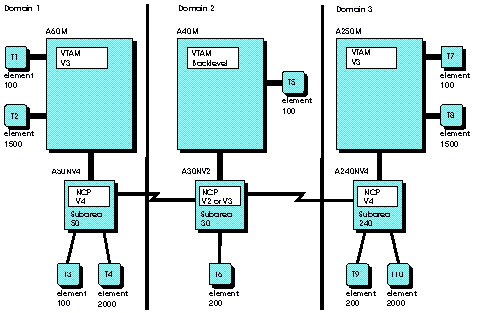 z/OS Communications Server: SNA Network Implementation Guide
z/OS Communications Server: SNA Network Implementation Guide
 z/OS Communications Server: SNA Network Implementation Guide
z/OS Communications Server: SNA Network Implementation Guide
|
Previous topic |
Next topic |
Contents |
Contact z/OS |
Library |
PDF
Compatibility between nonextended and extended network addressing nodes z/OS Communications Server: SNA Network Implementation Guide SC27-3672-01 |
|||||||||||||||||||||||||||||||||||||||||
|
You can use the MAXSUBA start option or the MAXSUBA operand in NCP to enable subareas with different addressing structures to communicate. For a network containing nonextended addressing nodes, the MAXSUBA start option specifies the highest subarea value that can be used throughout the network. A MAXSUBA of 63, for example, defines a network with up to 63 subareas and 1024 elements in each subarea. Code the MAXSUBA start option in the start option list if you want VTAM® to communicate with nonextended addressing nodes, or if the MAXSUBA operand is coded in an NCP that VTAM will communicate with. Extended network addressing is a network addressing structure that increases the size of the subarea address up to 255 in conjunction with up to 32 768 elements. VTAM extends host element addressing to 65 535 elements. Nonextended addressing nodes can continue to use this structure.
They can, however, participate in an extended network addressing network
only when the following two conditions are met:
In addition, the following restrictions apply when extended and
nonextended addressing nodes coexist in the same network:
Figure 1 illustrates an element address
incompatibility. Domain 1 contains nodes that use extended network addressing.
Domain 2 contains nodes that use nonextended addressing node addresses.
All nodes have defined a MAXSUBA of 63. Although all of the subareas
are within the MAXSUBA, some of the element addresses exceed the maximum,
which is 1023. Following are two address constraints on this network:
Figure 1. Element and subarea address incompatibility
in multiple-domain environment
 These limitations can be overcome through SNA network interconnection (SNI), which can be used to place nonextended addressing nodes and extended network addressing nodes into separate networks. See Connecting multiple subarea networks for information about implementing SNI. Although it is not recommended, a network containing nonextended
addressing nodes can have subareas whose subarea number is greater
than the MAXSUBA. The nonextended addressing nodes are unable to communicate
with these subareas. In this situation, the following constraints
apply:
Table 1 and Table 2 show the adjacent and endpoint node subarea requirements.
Figure 1 illustrates these constraints. The third domain contains extended network addressing nodes whose subarea addresses are greater than MAXSUBA. The following communication restrictions apply to the network in Figure 1:
As with the element address problem, subarea address incompatibilities can be avoided by using SNI to place nodes in separate networks. See Connecting multiple subarea networks for information about implementing SNI. 


|
|||||||||||||||||||||||||||||||||||||||||
 Copyright IBM Corporation 1990, 2014 Copyright IBM Corporation 1990, 2014 |